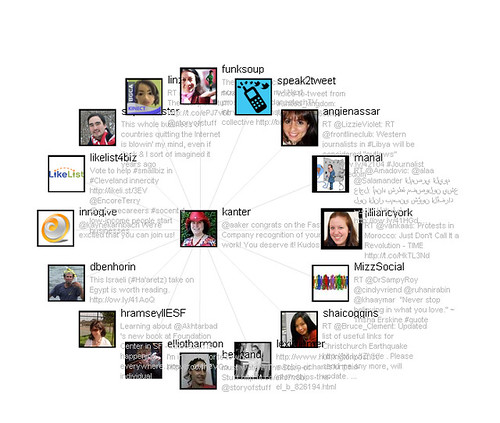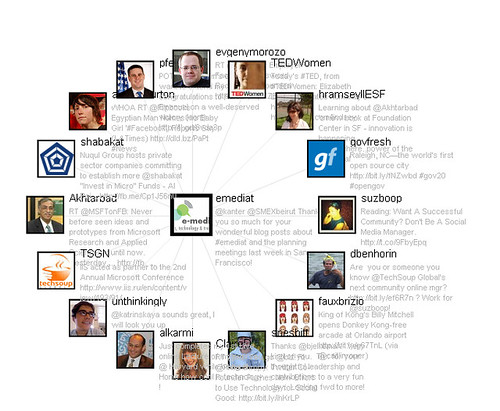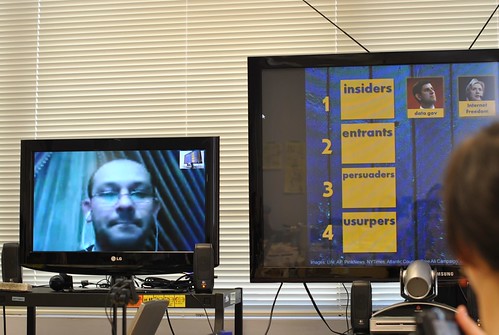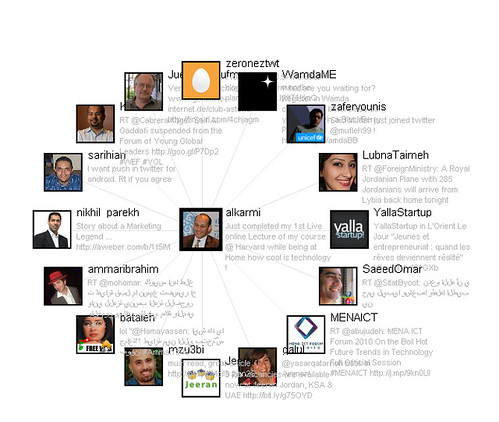
When we apply a network mindset to the way we work – whether as an individual or as part of a network strategy, we believe that value is created through our connections, interactions and building relationships. That’s social capital and it does have value. The impact, longer term, is innovation or the result of the network in action.
Let’s focus on the very first steps. Once you or your organization views the world with a networked mindset, then you need to visualize the network. There are many approaches and visual analysis tools. Let’s look at the ones that allow you to see the current relationships and potential ways to weave them on social media and social networks like Twitter. There are many tools to visualize your Twitter network. While they are fun (and addicting), they are most useful if you set aside some time to not only generate the visual, but think about what does it mean for your current practice.
The discipline of noticing your own practice in adopting a network mindset is important. This has been the most important lesson for me in shifting the way I work to a more networked approach. It doesn’t happen overnight and it takes daily practice. One efficient technique is to spend five minutes of your day at the end reflecting. What if you used that five minutes of reflection, to visualize and understand your network?
The 5K Visual Browser is one tool that help you see connections between the people you interact with on Twitter. Based on what I could figure out by staring at the visual that the app generated about my network (see above), this Twitter app lets you search a Twitter user name and it will show you who they are having conversations with and who is connected. You can click on any given user and it will show their connections.
The visual at the top shows the people who I’ve been connecting with on Twitter in the last week or so. A number of those on the visual are connecting with the E-Mediat Project,a networked capacity building project in the Middle East and more recently colleagues from TechSoup Global Summit who are partners on the E-Mediat project.

I’m leaving on Friday to travel to Beirut as part of the eight-day Train the Trainers component of the E-Mediat project. The first day of training is this Sunday and we’ll be covering networked approaches for NGOs and social media trainers. The participants include in-country teams from six different countries: Jordan, Lebanon, Morocco, Tunisia, United Arab Emirates, and Yemen. On each team, we have master trainers, training center coordinators, and social media advisors. As part of that first day, we’ll be creating individual and collective network maps.
In addition to my own map above, I generated maps of the social media advisors on Twitter to look at their networks and connections. It is interested that we do not yet have many overlapping connections.
For example, Rami Al-Karmi, Founder and CEO of Shabakat, Al Ordon (JordanNet) and is serving as the E-Mediat Strategic Adviser for the Jordan In-Country Team. Among his many accomplishments, he runs the very popular “Tech Tuesdays” in Jordan where Arab social media geeks meet up regularly. His organization’s name, Shabakat, translates into the word “network,” and is a terrific example of a Networked Nonprofit in the Arab world.


Beth Kanter is a consultant, author, influencer. virtual trainer & nonprofit innovator in digital transformation & workplace wellbeing.

Leave a Reply